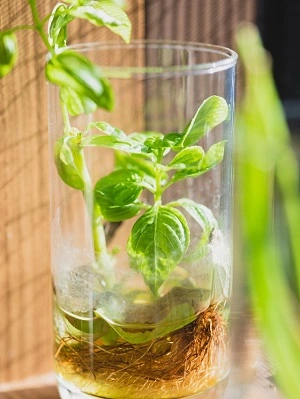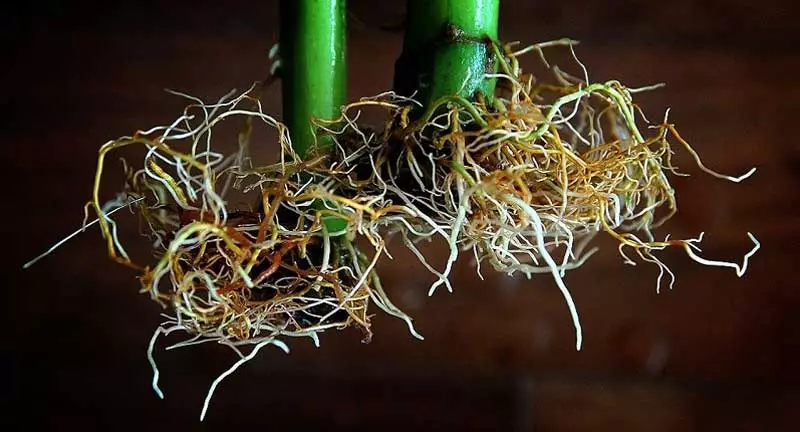Root Rot is a very common problem in hydroponics. This happens because of many reasons. There can be an imbalance of nutrients or your controlled environment may not be as sterile as you think. This makes a favourable place for the germs and microorganisms that cling to the roots making them browning, soft and greasy. In natural conditions, the roots of your hydroponics should be firm and white.
Root rot is common in hydroponic plants and is characterised by a slowdown in growth, yellow leaves, greasy roots, and roots turning black and brown. It can be fixed by using organic fungicides like hydrogen peroxide or chemical fertilizers like hydro guard etc. . Root rot is not a permanent problem and can be easily solved if diagnosed at an early stage or else it could destroy the whole plant.
As you already know that plants use roots to deliver essential nutrients. The roots also have the additional functionality of absorbing moisture and oxygen from the surroundings.
Root rot is more common in deep water culture systems like the raft system or the Kratky method. Root rot causes bacteria to block these functionalities of the root.
Some of the common forms of bacteria known to cause root rots to come from the genus Phytophthora family. P. Cinnamomi is the bacteria that causes your root rot. Other bacteria that cause root rots are Fusarium, Pythium (not python :D), and Rhizoctonia. Some kinds of fungi can also cause root rots in hydroponics.
I have discussed various ways in which we can counter rotten roots and whether it is a good idea to protect a plant and does using fungicides really work. Let’s get started.
Disclosure: Some of the links below are affiliate links, meaning at no extra cost to you, I will earn a commission if you click through and make a purchase.
Symptoms of Root Rot in Hydroponics
- The noticeable slowdown in growth
- Yellowing and falling old leaves. Newer ones not growing as fast as they should.
- Root Hair becoming brownish and blackish
- Roots become greasy and slimy
- No white coloured roots (healthy ones)
- The roots become so weak then when pulled out from grow media they tend to break or leave some parts of them in the solution itself


Also Read “How to get rid of Algae in Hydroponics forever”
Why Root Rot occurs in Hydroponics?
There are many reasons some are listed below
The primary reason is due to overwatering the plant. That is why air pumps are so important to maintain the aeration of the solution tank so that dissolved oxygen levels are maintained.
Other reasons, can be bacterial or fungal attacks and over the limit use of the fertilizers in the hydroponic nutrient solution may block the roots to get oxygen.
Other factors that are not primary to root rot but can stimulate root rot are too high or too low temperatures.
Hydroponic Root rot treatment
There are various ways in which you can get rid of the root rot. One thing here to keep in mind is that you won’t be able to retain the damaged roots. Those are already dead and will not be reinstated.
So, we only got one solution, determine the cause of root rot and get rid of it. Now, as you know root rot can occur due to many reasons.
There are different steps involved in treating root rots, based on the type to root rot, whether it is developed due to bacteria, fungi or overdosage of fertilizer and pesticide.
Treating root rot with hydrogen peroxide
Hydrogen peroxide on one magic formula for most of the problems in hydroponics. If you have read my article on how to get rid of algae in hydroponics, I have mentioned hydrogen peroxide there as well.
So, Hydrogen Peroxide H2O2 is a natural fungicide for root rot and is used to protect hydroponics from algae and any kind of bacterial and fungal infections. It also provides added oxygen to the roots boosting growth. That makes it a very powerful fungicide.
Hydrogen Peroxide Dilution Calculator For Hydroponics & Other Household Activities
Note: Before using any fungicide on your plant be sure to determine the “fungus group” that is active on your hydroponic. This is important as every fungicide can work on a limited group of fungus. Also, the name of your plant should be mentioned on the fungicide label.
Here are the steps to treat root rot with hydrogen peroxide.
- Get a 3% V/v solution of hydrogen peroxide
- Add 60-65 mL of 3% solution to 1-litre of water
- Put the solution in a spray bottle
- Spray this solution directly on the roots of your fungal infected hydroponic plant
- Repeat step 4 every day or every second day for a week.
- Observe the difference and use it again if necessary
- If you want to store the solution, use a cool and dark place to store it.
Using hydrogen peroxide for root rot is beneficial in two ways. Firstly it is purely organic and secondly, it kills the fungus and also provides extra oxygen support to the roots.
Also, Read “pH Down guide for Hydroponics“
Treating root rot with Hydroguard
Hydroguard is a type of chemical fertilizer that is used to kill fungus in plants and roots. Other fertilizers available in the market include Great White root booster, etc. These fertilizers can kill a host of fungus groups and can be applied to a huge variety of hydroponic plants.
Botanicare Hydroguard is a commercial fertilizer used to kill fungus and other kinds of bacterias in hydroponics and soil plants. In traditional farming, people use these types of pesticides throughout the growth and harvest stages of the crop to keep it healthy. In hydroponics, we only use this when in trouble.
There are some benefits of using hydro guard, for example, it helps strengthen the root mass and also breaks down other types of organic matter like algae.

The usage instructions as per the manufacturer say, to make a gallon of hydro guard solution we need to mix 2 ml of the solution with 1-gallon water. You can store the solution once made. Before reusing the solution, be sure to shake it well.
Also, if you want to adjust the pH level, mix the hydroponic solution thoroughly with the hydro guard before doing so. Otherwise, the pH level may fluctuate after some time.
Manual Hydroponic Root Rot Treatment
We have already discussed the easy ways to get rid of the root rot in your indoor or outdoor hydroponics garden. But maybe you are just starting off and don’t want to indulge in buying all these fancy formulae and all to remove root rot. Also, maybe the root rot is not that prevalent in your case.
So, you can choose to remove the root rot manually as well. Let me walk you through that too.
- Drain out the system and disconnect all the electronic components of your hydroponic system
- Take the plants with root rot out from growing media. This will be easy if you are using clay pellets, coconut coir, or peat moss, and a little difficult if you are using Rockwool, or ready-made grow plugs.
- Wash the roots in running water. Make sure the pH level of water is in the normal range (close to 7).
- Gently rinse the roots, taking the extra water and debris away.
- With the help of a scissor or a knife, pick the roots that are infected (yellowish/brownish in colour and greasy) and cut them off from the plant one by one.
- Wash your reservoir with hydrogen peroxide solution if possible or just water will do.
- Refill the reservoir with a nutrient solution. Don’t fill it completely this time, only such that the roots are in it and not floating.
- Setup the plants inside the reservoir and start the hydroponic system. Keep the air pump running 24×7 and maintain the temperature at 20-25 degrees celsius.
- Monitor the root growth after some days. If all the roots are doing well ( white and brittle) then you can increase the level of nutrient solution.
- If not then you have no option but either to use hydrogen peroxide or hydroguard to get rid of that nasty root rot.
Best Practices to Prevent Root Rot in Hydroponics
- Maintain the required pH level in the hydroponic system
- Put only a limited quantity of hydroponic nutrients in the reservoir enough for the first few weeks, while planting new seedlings.
- The extra nutrient solution may start root rot especially in younger plants, so we wait for the roots to get stronger before topping up the reservoir to the fullest
- Use an air pump and an air stone if possible to keep the nutrient solution well aerated. The bubbles should be noticeable
- Root rot can also happen due to algae attacks. Check this article on how to save your hydroponics from algae.
Also Read “Top 10 Fan for Grow Tent Ventilation“
Root rot in LECA
If you observe signs of overwatering for the plant, switch to the shower method, and start using Physan 20 by spraying it into the root base. Physan 20 is an algaecide, fungicide, bactericide, and virucide.
Alternatively, you can also shower with some hydrogen peroxide added to the water, this helps keep root rot at bay without disturbing the root system. If the plant continues to decline, remove the plant from LECA and check for root rot. Clip off the dead roots and spray with hydrogen peroxide and try again.
Do not take the plant out of LECA frequently to check roots. Plants don’t like their roots disturbed and this can add to the stress of transplanting.
If you observe signs of underwatering for the plant, switch to the reservoir method, or shower more frequently. This is uncommon, as LECA usually holds quite a bit of moisture. This could be a sign that the potting setup isn’t correct (water level too low below plant’s roots).
FAQ
Does Hydroguard kill root rot?
Yes, Hydroguard kills root rot. It is a chemical fungicide used to treat root rot in hydroponics. It also strengthens the roots and breaks other organic matter like algae present in the nutrient solution. This helps to increase the dissolved oxygen level in the solution and plant growth is boosted.
How to prevent root rot?
To prevent root rot you should take precautionary measures. Maintain the pH level of your solution. Use the limited quantity of nutrient solution and keep changing it in regular intervals. Keep the hydroponic system sterile and use an air pump as much as possible. Do not try to fight root rot. Once the roots are damaged you will have to remove them manually or use a fungicide like hydro guard or hydrogen peroxide.
Does peroxide cure root rot?
Yes, Hydrogen peroxide is an effective organic solution to cure root rot. It is also used to get rid of algae in hydroponic systems. The Hydrogen Peroxide can be sprayed over the roots for a period of two to three weeks. The peroxide also helps in adding extra oxygen to the roots which help in the growth of the hydroponic plant.

